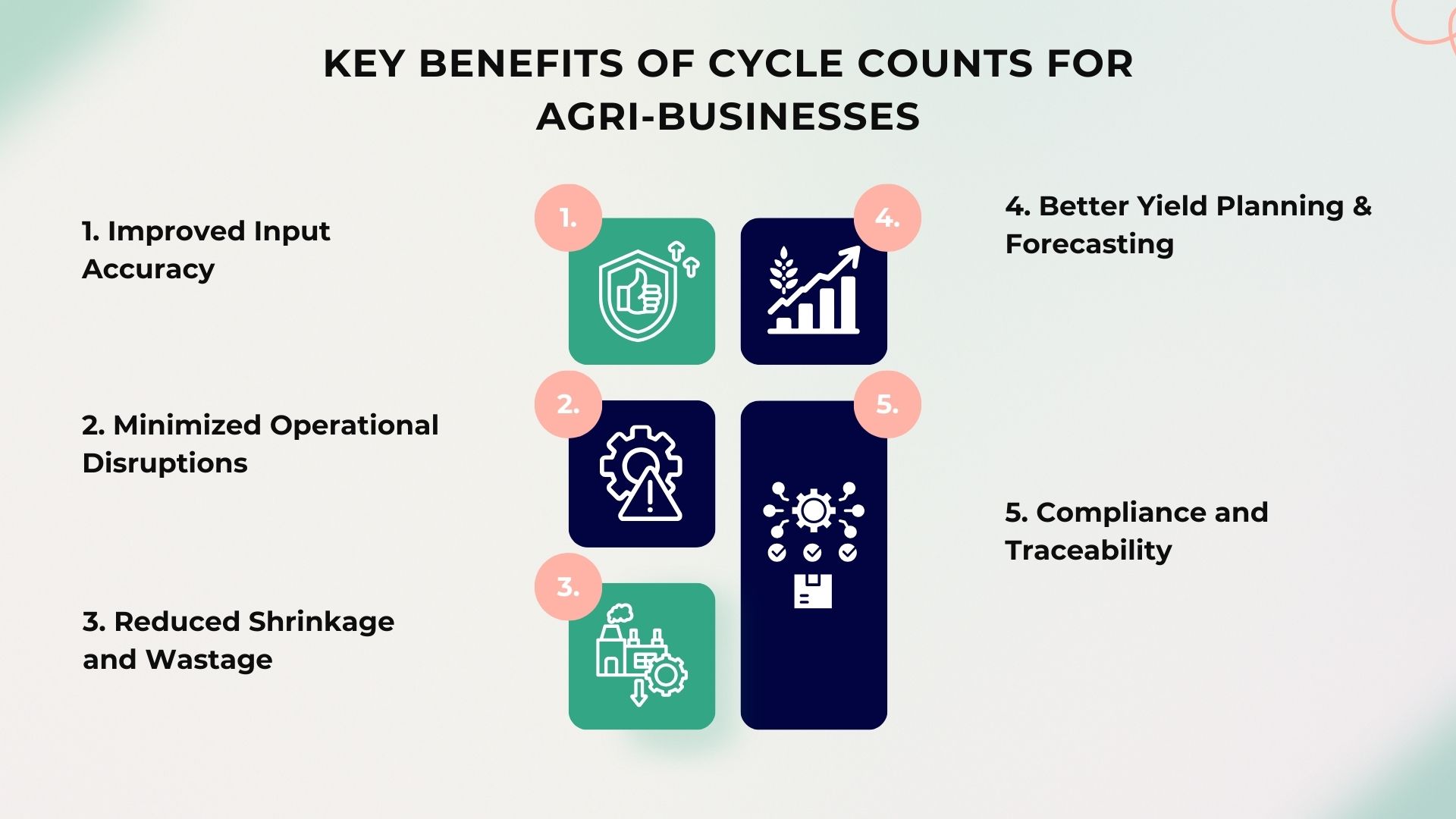Have you stepped into your warehouse and thought “We had more of this inventory last week? Or less of this”? This doubtful situation is exactly why the accuracy of your inventory matters the most. According to IHL Group, mismanaged inventory leads to losses of over $1.1 trillion globally every year. So this is not a small mistake, but rather a hefty one.
If you manage an agricultural business, in that case, whether it is grain, dairy, or seeds, it is critical to know about your inventory. One of the best ways to stay ahead in this arena is by adopting cycle counts. The benefits of implementing cycle counts go far beyond just knowing how many bags and what is left.
AgriERP is one of the best solutions that is helping farms and agricultural warehouses make this process simple and accurate without disrupting your operations. But first, let us have a look at what cycle counting does and why you should consider it.
Key Benefits of Cycle Counts for Agri-Businesses
 When it comes to agriculture, it is far different from retail. Your inventory includes perishables, inputs that are season-sensitive, and also items with very short shelf lives. So, tracking them in real-time makes all the difference. Here is how adopting cycle counts can help:
When it comes to agriculture, it is far different from retail. Your inventory includes perishables, inputs that are season-sensitive, and also items with very short shelf lives. So, tracking them in real-time makes all the difference. Here is how adopting cycle counts can help:
1. Improved Input Accuracy
You simply can not grow a crop if you do not know how much fertilizer or pesticide you have in stock. With the help of cycle count in inventory management, you do not have to second-guess your input stock.
When you adopt routine cycle counting, your data is always up to date. You know exactly how many seed bags are available, whether the pesticide drums are near their expiry, and how much irrigation equipment is available to you. This helps you avoid overuse, underuse, or in the worst case running out during planting or harvesting seasons.
Accurate inputs also mean fewer surprises when you have to make procurement decisions. And when your records are transparent, you are in a better position to make smart and informed choices that positively impact your yields.
2. Minimized Operational Disruptions
The old-style and traditional full-inventory audits are time-consuming and very exhausting. To execute them you have to shut down everything, put your staff to the task of manual counts, and hope that nothing is missed. One of the biggest advantages of cycle counting is that you do not have to halt your business operations.
Cycle counts can be carried out without disrupting any operation in the background. Moreover, this can be done during off-peak hours or staggered shifts, so that your warehouse keeps running, trucks keep moving, and your team does not get overwhelmed.
This high flexibility is highly beneficial when you are managing large warehouses or multiple storage locations. You can choose which category or section to count when to count it, and the frequency of the counts. This gives you immense control over your operations.
3. Reduced Shrinkage and Wastage
One of the less discussed and acknowledged benefits of inventory cycle counts is shrinkage prevention. Cycle counting helps you stay proactive and catch everything early, whether it is missing inventory, expired chemicals, or perishable items going bad in cold storage.
When you inculcate these small checks into your daily or weekly routine, you can easily reduce the chance of finding half your stock unusable. This high level of visibility is also vital when you are handling temperature-sensitive items or restricted-use pesticides.
Companies that use frequent cycle counts come across errors and discrepancies early on which help minimize shrinkage and prevent stockouts or waste caused by expired inventory.
4. Better Yield Planning & Forecasting
Let us take an example you are prepping for corn season and you have to plan seed distribution and fertilizer logistics. Without accurate inventory data at your hand, your yield forecast can come crumbling down.
This is where improving inventory accuracy with cycle counts helps in better planning. When your numbers reflect reality, your procurement matches with actual demand, and not merely guesswork. This means fewer emergency orders and tighter cost control.
And when this is used with farm planning modules (like those in AgriERP), you can match actual stock levels with what your fields will need in real-time.
5. Compliance and Traceability
Audits cannot be avoided in any circumstances, regardless of whether you are working toward USDA organic certification or getting ready to ship to Europe. The fact that it facilitates complete traceability depicts the importance of cycle counting and is a major advantage.
By keeping your inventory up-to-date and logged in digitally, you are always ready for an audit. This is very helpful in tracking inputs across growing seasons, when, where, and how items were used.
With cycle counts feeding data constantly into your inventory system, you are no longer going around scouring through manual records before an inspection. You already have the documentation.
Industries & Roles That Benefit Most
Cycle counts are not only for warehouses. Everyone who is involved from production to distribution can benefit from them in an agribusiness. Let us see who gains the most from implementing them:
Grain & Seed Producers
When you are working with high-volume and time-sensitive stock like seeds and grains, cycle count in inventory management helps manage the movement of tons of produce. Regular counts can keep drying and storage facilities running without any disruptions.
Livestock & Dairy Farms
Every day, milking supplies, medication, and feed must be monitored. Frequent cycle counts help you keep track of usage trends prevent spoiling, and avoid reordering.
For example, if calf feed is running low but is not reflected correctly in your inventory, that can cause a delay. With the help of accurate counts, you will always be one step ahead.
Agri-Warehouses & Distributors
Distribution centers handle thousands of SKUs, from pesticides to irrigation parts. They can keep everything in order without executing extensive inventory audits by improving their inventory management using cycle counts. Moreover, it helps in the alignment of delivery and supplier schedules with the actual stock at hand.
Farm Operations Managers & Supply Chain Heads
If you are handling procurement, stock flow, or logistics, then data accuracy will mean better decision-making. With cycle counts providing regular updates to your system, you can identify trends, respond swiftly to shortages, and prevent over-purchasing.
Cycle Counts in Action – Powered by AgriERP
So how does all this work in real life?
AgriERP is an ERP solution developed exclusively for catering the needs of agribusinesses. It is a modern and mobile-friendly solution that will empower you to manage your cycle counts efficiently. No more scouring through spread-out spreadsheets and disjointed systems, just open the app, scan the item with a barcode or RFID, and let it sync with your inventory.
You can schedule cycle counts according to the category, location, and expiry date of the item. Staff can perform counts right from the field or storage area. As soon as the system receives the data, it auto-reconciles it with purchase orders and consumption records.
This is not just for large operations. Even small or mid-sized agribusinesses can reap massive benefits from automating their cycle count workflows. According to Shopify’s guide, Real-time inventory management saves businesses an average of 10+ hours monthly on tasks by reducing manual data entry and physical counts. It optimizes stock levels and reduces carrying costs through better supply chain coordination.
So it does not matter if you are running a massive farm or managing a small enterprise, tools and powerful solutions like AgriERP give you a smart, scalable way to count what counts.
Conclusion
The benefits of implementing cycle counts are way more than simply being aware of how much stock is lying in the storage. In the case of agricultural businesses, cyclic counts help them maintain input accuracy, prevent disruptions, reduce waste, and support long-term planning. Periodic cycle counts enable farms, distributors, and warehouse managers to act proactively and prevent problems from escalating that can be the result of outdated or missing data.
They also support in complying with regulations and enhance digital traceability. These two factors are becoming increasingly important as international standards for food safety and sustainability continue to tighten. Whether you are managing a grain warehouse or running a livestock operation, accurate inventory gives you a transparent view of your business and a better way to cater to market demand.
If you are just stepping into the world of smarter inventory practices, then solid solutions like AgriERP can be your best ally. With the help of mobile-based cycle counting, automated reconciliation, and full integration of your farm operations, it is a powerhouse tool built exclusively for agriculture.
So, if you want to bring more control, clarity, and confidence to your inventory, it is the best time to explore AgriERP.com. You will be in awe of how smooth your season can go, with fewer surprises and a lot more peace of mind.








